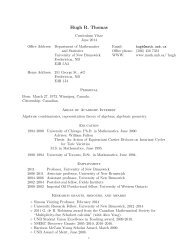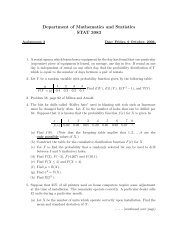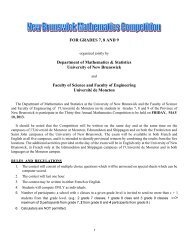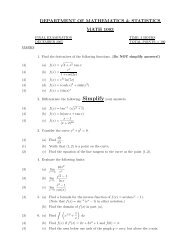Nonlinear boundary value problems (relaxation methods)
Nonlinear boundary value problems (relaxation methods)
Nonlinear boundary value problems (relaxation methods)
Create successful ePaper yourself
Turn your PDF publications into a flip-book with our unique Google optimized e-Paper software.
O restart;<br />
with(plots):<br />
with(LinearAlgebra):<br />
with(ArrayTools):<br />
with(PDEtools);<br />
CanonicalCoordinates, ChangeSymmetry, CharacteristicQ, CharacteristicQInvariants,<br />
ConservedCurrentTest, ConservedCurrents, ConsistencyTest, D_Dx, DeterminingPDE,<br />
Eta_k, Euler, FromJet, InfinitesimalGenerator, Infinitesimals, IntegratingFactorTest,<br />
IntegratingFactors, InvariantEquation, InvariantSolutions, InvariantTransformation,<br />
Invariants, Laplace, Library, PDEplot, PolynomialSolutions, ReducedForm,<br />
SimilaritySolutions, SimilarityTransformation, Solve, SymmetrySolutions, SymmetryTest,<br />
SymmetryTransformation, TWSolutions, ToJet, build, casesplit, charstrip, dchange, dcoeffs,<br />
declare, diff_table, difforder, dpolyform, dsubs, mapde, separability, splitstrip, splitsys,<br />
undeclare<br />
<strong>Nonlinear</strong> <strong>boundary</strong> <strong>value</strong> <strong>problems</strong> (<strong>relaxation</strong> <strong>methods</strong>)<br />
(1)<br />
The purpoe of this worksheet is to solve a nonlinear <strong>boundary</strong> <strong>value</strong> problem using Newton's method.<br />
Here is the <strong>boundary</strong> <strong>value</strong> problem we want to solve:<br />
O ode := diff(u(x),x,x) + V(u(x))-f(x);<br />
BC := u(0) = a, u(1) = b;<br />
ode :=<br />
d2<br />
dx 2 u x C V u x K f x<br />
BC := u 0 = a, u 1 = b<br />
(2)<br />
In this, V and f are arbitrary functions. We make use of the following procedure to generate a finite<br />
difference stencil of the ODE:<br />
O centered_stencil := proc(r,N,{direction := spatial})<br />
local n, stencil, vars, beta_sol:<br />
n := floor(N/2):<br />
stencil := D[1$r](u)(x) - add(beta[i]*u(x+i*h),i=-n..n);<br />
vars := [u(x),seq(D[1$i](u)(x),i=1..N-1)];<br />
beta_sol := solve([coeffs(collect(convert(series(stencil,h,<br />
N),polynom),vars,'distributed'),vars)]):<br />
stencil := subs(beta_sol,stencil):<br />
convert(stencil = convert(series(stencil,h,N+2),polynom),<br />
diff);<br />
end proc:<br />
In particular, our stencil for the derivative is:<br />
O centered := isolate(lhs(centered_stencil(2,3)),diff(u(x),x,x));<br />
centered :=<br />
d2<br />
dx 2 u x = u x K h<br />
h 2 K 2 u x<br />
h 2 C u x C h<br />
h 2<br />
Putting this in the ODE yields:<br />
O stencil := subs(centered,ode);<br />
(3)<br />
(4)
stencil := u x K h<br />
h 2<br />
K 2 u x<br />
h 2<br />
C u x C h<br />
h 2 C V u x K f x<br />
(4)<br />
We relabel various things for ease of reading:<br />
O Subs1 := [seq(u(x+i*h)=u[j+i],i=-1..1),f(x)=f[j]];<br />
Subs1 := u x K h = u j K 1<br />
, u x = u j<br />
, u x C h = u j C 1<br />
, f x = f j<br />
In terms of these, the stencil becomes<br />
O stencil := expand(subs(Subs1,stencil)*(-h^2/2));<br />
stencil := K 1 2 u j K 1 C u j K 1 2 u j C 1 K 1 2 h2 V u j<br />
C 1 2 h2 f j<br />
Now, if V is a nonlinear function, this will be a set of nonlinear equations for u[j]. We linearize the<br />
equations the equations by first make the substitutions:<br />
O Subs2 := [seq(u[j+i]=U[j+i]+epsilon*dU[j+i],i=-1..1)];<br />
Subs2 := u j K 1<br />
= U j K 1<br />
C e dU j K 1<br />
, u j<br />
= U j<br />
C e dU j<br />
, u j C 1<br />
= U j C 1<br />
C e dU j C 1<br />
(5)<br />
(6)<br />
(7)<br />
In this, U is a guess for u and dU is the error in that guess. Putting these into stencil and then expanding<br />
to linear order in epsilon yields:<br />
O linear_stencil := series(subs(Subs2,stencil),epsilon,2);<br />
linear_stencil := convert(linear_stencil,polynom);<br />
linear_stencil := collect(subs(epsilon=1,(linear_stencil = 0)-<br />
subs(epsilon=0,linear_stencil)),[dU[j-1],dU[j],dU[j+1]]);<br />
linear_stencil := K 1 2 U j K 1 C 1 2 h2 f j<br />
C U j<br />
K 1 2 U j C 1 K 1 2 h2 V U j<br />
C dU j<br />
K 1 2 dU j K 1 K 1 2 h2 D V U j<br />
dU j<br />
K 1 2 dU j C 1<br />
e C O e 2<br />
linear_stencil := K 1 2 U j K 1 C 1 2 h2 f j<br />
C U j<br />
K 1 2 U j C 1 K 1 2 h2 V U j<br />
C dU j<br />
K 1 2 dU j K 1 K 1 2 h2 D V U j<br />
dU j<br />
K 1 2 dU j C 1<br />
e<br />
linear_stencil := K 1 2 dU j K 1 C 1 K 1 2 h2 D V U j<br />
dU j<br />
K 1 2 dU j C 1 = 1 2 U j K 1<br />
(8)<br />
K 1 2 h2 f j<br />
K U j<br />
C 1 2 U j C 1 C 1 2 h2 V U j<br />
Written in this way, we see that linear stencil is a tridiagonal matrix problem for the error vector dU. The<br />
procedure GenerateSystem take an initial guess U, and the various quantites appearing in the ODE (a b,<br />
V, f) and a stepsize h and returns the linear system to be solve for dU in matrix form.<br />
O beta := unapply(rhs(linear_stencil),j,U,h,V,f); # This procedure<br />
generates the RHS of linear stencil for each j<br />
GenerateSystem := proc(U,a,b,V,f,h)<br />
local M, UU, A, B:<br />
M := Dimension(U):<br />
UU := Array(0..M+1,[a,op(convert(U,list)),b]): # We augment<br />
the initial guess for the solution vector by adding the BCs at<br />
either end
A := BandMatrix([[-1/2$(M-1)],[seq(1-1/2*h^2*D(V)(UU[i]),i=1.<br />
.M)],[-1/2$(M-1)]],1,M): # this matrix reproduces the LHS of<br />
linear stencil<br />
B := Vector(1..M,[seq(beta(i,UU,h,V,f),i=1..M)]); # This<br />
vector is the RHS of linear stencil for all j<br />
A,B:<br />
end proc:<br />
b :=<br />
j, U, h, V, f / 1 2 U j K 1 K 1 2 h2 f j<br />
K U j<br />
C 1 2 U j C 1 C 1 2 h2 V U j<br />
(9)<br />
We test our GenerateSystem procedure on a dummy guess vector UU with five entries.<br />
O M := 5;<br />
UU := Vector([seq(U[i],i=1..M)]);<br />
GenerateSystem(UU,a,b,V,f,h);<br />
M := 5<br />
U 1<br />
U 2<br />
UU :=<br />
U 3<br />
U 4<br />
U 5<br />
1 K 1 2 h2 D V U 1<br />
, K 1 2<br />
, 0, 0, 0 ,<br />
(10)<br />
K 1 2 , 1 K 1 2 h2 D V U 2<br />
, K 1 2 , 0, 0 ,<br />
0, K 1 2 , 1 K 1 2 h2 D V U 3<br />
, K 1 2 , 0 ,<br />
0, 0, K 1 2 , 1 K 1 2 h2 D V U 4<br />
, K 1 2 ,<br />
0, 0, 0, K 1 2 , 1 K 1 2 h2 D V U 5<br />
,<br />
1<br />
2 a K 1 2 h2 f 1<br />
K U 1<br />
C 1 2 U 2 C 1 2 h2 V U 1<br />
1<br />
2 U 1 K 1 2 h2 f 2<br />
K U 2<br />
C 1 2 U 3 C 1 2 h2 V U 2<br />
1<br />
2 U 2 K 1 2 h2 f 3<br />
K U 3<br />
C 1 2 U 4 C 1 2 h2 V U 3<br />
1<br />
2 U 3 K 1 2 h2 f 4<br />
K U 4<br />
C 1 2 U 5 C 1 2 h2 V U 4<br />
1<br />
2 U 4 K 1 2 h2 f 5<br />
K U 5<br />
C 1 2 b C 1 2 h2 V U 5
Notice how a and b (the parameters in the <strong>boundary</strong> condition) appear in the B vector. The algoirthm we<br />
pursue is similar to the one employed for the nonlinear Crank-Nicholson problem: We guess the solution<br />
vector U, solve the linear system from GenerateSystem for dU, and then update our original guess via U<br />
= U + dU. The algoirthm terminates when dU gets small; i.e., with the RMS <strong>value</strong> of each component in<br />
dU is less than a tolerance eps. BVP_solver is an implementation of this algorithm:<br />
O BVP_solver := proc(V,ff,a,b,M)<br />
local h, x, f, U, p, CONTINUE, eps, i, gnat, dU, err:<br />
h := evalf(1/(M+1)): # the stepsize<br />
x := Array(0..M+1,[seq(h*i,i=0..M+1)]):<br />
# an array containing x <strong>value</strong>s of the lattice<br />
f := map(x->ff(x),x):<br />
# the array containing the f[j]'s in linear stencil<br />
U := Vector(1..M,[seq(a+i/(M+1)*(b-a),i=1..M)],datatype=<br />
float): # our initial guess (straight line between [0,a] and [1,<br />
b]<br />
p[0] := plot([[0,a],seq([x[i],U[i]],i=1..M),[1,b]],axes=<br />
boxed,title=`iteration no. 0`): # first frame of a movie<br />
CONTINUE := true:<br />
eps := 1e-6: # the tolerance parameter that controls when<br />
Newton iterations stop<br />
for i from 1 to 50 while (CONTINUE) do:<br />
gnat := GenerateSystem(U,a,b,V,f,h):<br />
dU := LinearSolve(gnat): #<br />
solving for dU<br />
err := sqrt(dU.dU/M):<br />
# err is<br />
the RMS <strong>value</strong> of each component of dU<br />
if (err < eps) then CONTINUE := false fi: # if err<br />
< eps the loop stops<br />
U := U + dU: # updating the <strong>value</strong> of U<br />
p[i] := plot([[0,a],seq([x[j],U[j]],j=1..M),[1,b]],<br />
axes=boxed,title=cat(`iteration no. `,i)): # next movie frame<br />
od:<br />
display(convert(p,list),insequence=true):<br />
# the<br />
output is a movie of each stage of the Newton iterations<br />
end proc:<br />
The output of BVP_solver is a movie of the shape of our numeric solution of the BVP after each Newton<br />
iteration. Here is an example of the output for a nonlinear and inhomogeneous problem:<br />
O ff := x -> 5/(1+x^2):<br />
VV := u -> u*(1-u):<br />
aa := 20:<br />
bb := 25:<br />
BVP := [collect(dsubs(V=VV,f=ff,ode),[diff(u(x),x,x),u(x)],<br />
factor),op(dsubs(a=aa,b=bb,{BC}))];<br />
movie := BVP_solver(VV,ff,aa,bb,100):<br />
movie;<br />
d 2<br />
BVP :=<br />
dx 2 u x K u x 2 C u x K 5 , u 0 = 20, u 1 = 25<br />
2<br />
1 C x
25<br />
iteration no. 0<br />
20<br />
15<br />
10<br />
0 0.2 0.4 0.6 0.8 1<br />
One can also get dsolve/numeric to solve the BVP for comparison<br />
O UU := rhs(dsolve(BVP,numeric,output=listprocedure)[2]);<br />
still := plot(UU(x),x=0..1,color=blue,axes=boxed):<br />
still;<br />
UU := proc x ... end proc
25<br />
20<br />
15<br />
10<br />
0 0.2 0.4 0.6 0.8 1<br />
x<br />
Here is the movie and the still diplayed together. One can see it only take a few iterations for our method<br />
(red) to closely match the output of dsolve/numeric (blue).<br />
O display([movie,still]);
25<br />
iteration no. 5<br />
20<br />
15<br />
10<br />
0 0.2 0.4 0.6 0.8 1<br />
x


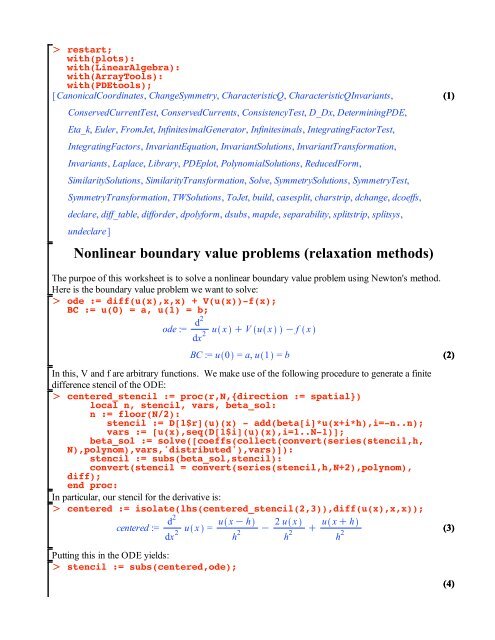
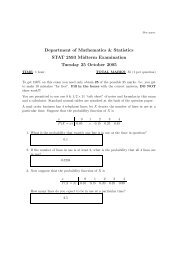
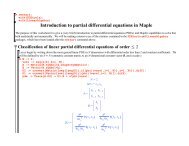
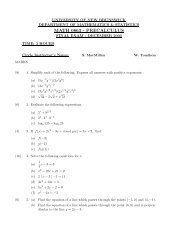

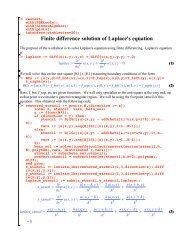
![1]] CHAPTER 2 LIMITS AND DERIVATIVES](https://img.yumpu.com/40053548/1/190x245/1-chapter-2-limits-and-derivatives.jpg?quality=85)

